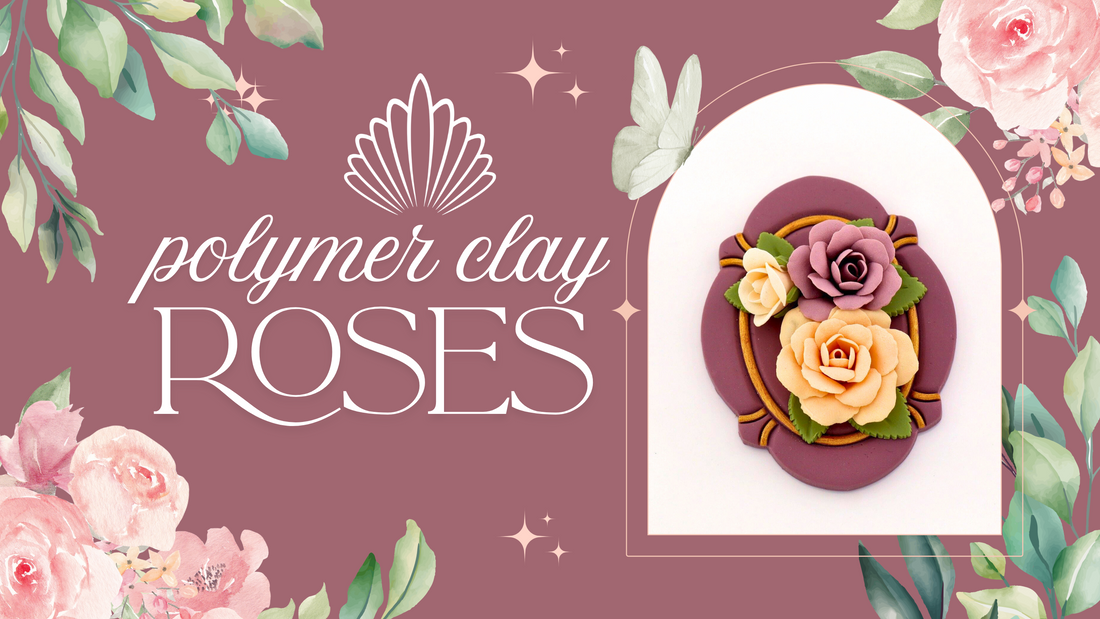
How to Make Polymer Clay Roses | Step-by-Step Tutorial with Video
How to Make Polymer Clay Roses
Polymer clay roses are a beautiful way to add delicate, realistic details to your jewelry and craft projects. This tutorial will walk you through the process of shaping, assembling, and finishing clay roses, including rosebuds and young roses, before arranging them into a bouquet. Prefer to watch instead of read? Skip to the video
Tools and Materials
To follow along, you’ll need:
- Rose Cutter Set - includes petals, leaves, and small sepal shapes
- Elsa Frame Cutter - for creating a base if desired
- Cutter Press - to assist in creating even pressure across the backs of the cutters
- Ball Tools - for thinning and shaping petals
- Smaller Ball Tools - for shaping and maneuvering petals
- Foam Petal Pad - to support petals while shaping
- Tissue Blade - for lifting and maneuvering clay pieces
- Metal/Pointed Tools - for picking up and positioning petals and leaves
- Oven-Bake Adhesive - for attaching raw clay to baked bases
- Sculpey Premo Clay - firm, flexible clay ideal for flowers
- Cornstarch
- Soft paint brush (optional)
Preparing the Clay
- Roll your clay very thin, about 0.7 mm (Atlas pasta machine setting #8).
- Ensure the clay is firm and not sticky. If it’s too soft, leach it first.
- Use Sculpey Premo or Soufflé for best results. These clays remain flexible and won’t shatter when handled thin.
Cutting and Shaping the Petals
The preparation of your petals is one of the most important steps. The goal is to create very thin, flexible shapes that can be cupped and bent into natural curves.
Cutting the Petals
- Roll your clay thin (about 0.7 mm).
- Dust your petal cutter with a little cornstarch to prevent sticking.
- Cut out your petals, pressing firmly and evenly (a cutter press helps).
- Slide a tissue blade under the base of the petals and gently peel the clay off the surface. This prevents distortion and keeps the edges sharp.
👉 Note: Flexible clays like Sculpey Premo peel cleanly. More brittle clays (such as Cernit, Pardo, or Fimo Professional) may crack or shatter when lifted.
Thinning and Cupping the Petals
- Place the petals onto a Foam Pad while still on the tissue blade.
- Using ball tools, press from the center outward in soft strokes to thin the clay and curve the edges upward.
- Continue in gentle arcs or circles until the petal is uniformly thin and shaped like a spoon.
Adding Realistic Edges
- Scalloped/Ruffled Look: Flip the tissue blade so the cupped side of the petals faces down. With a smaller ball tool, run along the edges in short outward strokes to create scalloped lines. Then press just inside the edge to bend the petal outward, reversing the curve you created earlier. This gives petals the soft, ruffled look of a natural rose.
- Smooth/Classic Look: Instead of scalloping, simply flip the tissue blade and press lightly near the tips. This bends the edges outward while keeping them smooth.
- Center Petal: Leave one of the largest petals untouched at this stage. Shape it only into a thin, curved spoon. This petal will be used to wrap around the cone and form the very center of the rose.
Handling Tips
- Keep petals on the tissue blade as long as possible while shaping.
- Only remove them once they’re fully formed and ready to be applied to the rose. This reduces breakage and keeps edges clean.
Building the Rose
- Start with a cone base: Form a small cone in the same color as your rose. This acts as the support for your petals and makes the flower easier to handle while building.
- Create the center: Take the large petal you left un-scalloped. Position the cone so its tip rests against the middle of the petal. Wrap one side of the petal around the cone, then fold the other side across to overlap. This creates the central curl of the rose and provides a secure base for the remaining petals.
-
Add layers of petals:
Begin with the smallest petals. Wrap them around the center, either
completing a full circle or stopping partway for a looser effect. Continue
with the next petal size, adding another loop around the rose center. Repeat
this process for all four petal sizes, working from smallest to largest.
- Wrap all the way around with each size for a dense, structured rose.
- Use only three to four petals per layer for a more open bloom.
- Adjust for size and style: For a small rose, stop after two or three layers. For a fuller bloom, continue until you reach the largest petal size.
- Balance the look: Adjust each petal as you go, tucking petals in for a tight, compact rose or bending them outward for a more open bloom.
Removing the Rose from the Cone
Once your rose is complete, the cone base can be trimmed away so the flower can be added to your arrangement.- Reduce the trunk: Roll the clay at the base of the rose between your fingers or with a thin tool, narrowing it into more of a stem. This helps lock the petals together and gives you a secure base.
- Decide the angle: If you want the rose to sit straight up, cut the base flat. For a tilted rose, cut the base at an angle.
- Slice it free: Use a sharp tissue blade to carefully cut across the trunk, separating the rose from the cone. You’ll be left with a flat base that can easily attach to another piece of clay.
- Check for security: Ensure the petals above the cut line are pressed together. If not, they may separate when the cone is removed.
Making a Young Rose
A rosebud or young rose follows the same basic method as a full rose but uses fewer petals and a tighter arrangement. The goal is to capture the look of a rose just beginning to open.
Choosing Petals
- Skip the very smallest petal size (it creates too much bulk near the center).
- Use about three of the next-smallest size petals.
- Add three to four of the second-largest petals for the outer layer.
- Use one of the largest petals for the center, wrapping it around the cone as you would for a full rose.
Shaping the Petals
- For a closed rosebud, leave the petals cupped like spoons and do not bend them outward.
- For a young blooming rose, shape the larger petals so their edges bend outward slightly while the smaller ones remain cupped.
Building the Rosebud
- Wrap the largest petal around the cone to form the center.
- Add the smaller petals closely around it, overlapping slightly.
- Continue with the second-largest petals, keeping the shape fairly tight. Adjust how far the petals bend outward depending on whether you want a closed bud or a young bloom.
Forming the Stem and Sepals
- Reduce the trunk into a slender stem by rolling it gently between your fingers.
- Wrap a thin strip of green clay around the base of the rose to form the calyx. Smooth the strip into the petals so there’s no harsh seam.
- Add about five small green sepals evenly spaced around the base. Let them extend just above the petals so they peek out naturally.
- Roll the stem again to blend everything smoothly and reduce to your desired thickness.
- Trim the stem to length only once you know how much you’ll need for your arrangement.
Creating the Leaves
- Roll out clay thinly (about 0.7 mm).
- Cut leaves in your desired size using a cutter.
- Add a center vein with a ball tool or pointed tool for a natural look.
Assembling the Bouquet
- Cut out the base shape: You can attach your leaves and roses to either a cured or uncured clay base.
- Attach leaves: Use Oven-Bake Adhesive or liquid clay to position the leaves first.
- Place the roses: Add the largest rose first, then nestle smaller roses or buds beside it.
- Adjust and zhuzh: Angle roses for variety and trim stems as needed so everything sits neatly.
Baking and Finishing
- Bake your bouquet according to the clay manufacturer’s instructions.
- The oven-bake adhesive will cure clear and matte, making it nearly invisible.
- Once baked, your roses will be secure and ready to use in jewelry or other projects.
Final Thoughts
With patience and practice, you can create roses in many styles, from tight buds to open blooms, and combine them into stunning floral arrangements. The video tutorial below demonstrates each step in detail, including shaping techniques, petal variations, and bouquet assembly.
